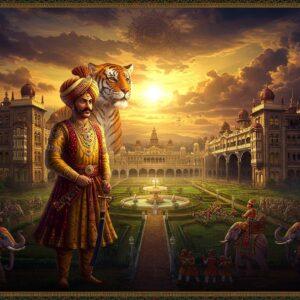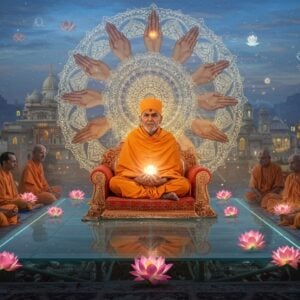
In the heart of Indian tradition, Dvarapalas, the gatekeepers of sacred spaces, hold a revered position. These majestic figures, often depicted as valiant warriors or awe-inspiring giants, stand guard with weapons like the formidable mace (gada), embodying protection and spiritual security. Their presence evokes a sense of reverence and awe, reminding us of the divine sanctity they safeguard.
At Poojn.in, we understand the deep cultural significance of Dvarapalas. We offer a divine collection of authentic Dvarapala statues and other sacred items, meticulously crafted to honor these revered guardians. Explore our collection here and bring the blessings of these protectors into your home.
Delving into the Significance of Dvarapalas
The term “Dvarapala” originates from the Sanskrit words “dvāra,” meaning door or gate, and “pāla,” meaning protector. These sentinels serve as both physical and spiritual guardians, believed to repel negativity and usher in positive energies. Their presence graces Hindu, Buddhist, and Jain traditions, each with its unique interpretation and reverence for these divine protectors.
Exploring the Diverse Representations of Dvarapalas
Across the rich tapestry of Indian art and architecture, Dvarapalas assume diverse forms. From the intricate Dravidian carvings of South India, as seen in the magnificent Brihadeeswarar Temple, to the distinctive Nagara style of North India, these statues showcase the artistic brilliance of skilled artisans. Crafted from materials like stone, metal, or wood, each Dvarapala statue reflects the region’s unique artistic heritage, passed down through generations.
Looking to enhance your home’s spiritual ambiance? Explore our exquisite collection of wooden wall panels and decorative items at Poojn.in. These meticulously crafted pieces add a touch of traditional elegance to any space.
Unveiling the Symbolism and Iconography
Dvarapalas often appear in fierce expressions and warrior attire, armed with symbolic weapons. These powerful depictions signify their role as protectors, inspiring devotees to confront their inner fears before entering a sacred space. Their imposing presence serves as a deterrent against negativity, preserving the sanctity within. They remind us of the strength and courage needed to overcome challenges on our spiritual path.
Enhance your spiritual journey with our authentic clay diyas and other pooja essentials. Create a sacred ambiance in your home with Poojn.in.
Dvarapalas in Contemporary Times
Even in modern times, Dvarapalas retain their significance in art, architecture, and cultural expressions. They feature prominently in festivals and rituals, symbolizing strength and protection. As traditional motifs find their way into urban homes, Dvarapalas grace home décor, reflecting a growing appreciation for heritage and spirituality. Digital platforms further amplify their reach, sharing their stories and significance globally.
Preserving the Legacy: Caring for Dvarapala Artifacts
Preserving these cultural treasures requires a deep understanding of their historical and spiritual context. Regular cleaning and careful restoration are essential to prevent damage and maintain their integrity. Ethical acquisition and respectful handling of these artifacts are crucial to safeguarding their cultural heritage. Museums and cultural institutions play a vital role in educating the public about the significance of Dvarapalas in Indian art history. You can also find exquisite Laddu Gopal Ji attire at Poojn.in, perfect for honoring the divine presence in your home.
Exploring the Origins and Purpose
- Dvarapalas find their roots in tutelary deities like Yaksha and warrior figures such as Acala. Their presence connects us to ancient traditions and spiritual lineages.
- They stand guard at Hindu, Buddhist, and Jain temples, royal palaces, and other sacred sites, marking the boundary between the mundane and the divine.
Understanding the Forms and Depictions
- Dvarapalas are often portrayed as fierce, armed guardians, embodying strength and protection. Their appearance itself wards off negative energies.
- From fierce expressions to serene composure, standing tall or kneeling in reverence, Dvarapalas exhibit a range of postures and expressions, each rich with symbolism.
Cultural Variations and Global Presence
- Dvarapalas are an integral part of Hindu, Buddhist, and Jain cultures, with their influence extending to regions like Java, Bali, Cambodia, and Thailand, showcasing their widespread cultural impact.
- The artistic styles vary across regions, reflecting the local traditions and materials. From the bulky giants of Java and Bali to the leaner figures of Cambodia and Thailand, each style tells a unique story.
Specific Roles in Different Religions
- In Hinduism, Dvarapalas grace almost every temple, safeguarding the sanctity of the divine space. Their presence signifies the protective embrace of the divine.
- In Buddhism, Nagas, Yakshas, and Bodhisattvas serve as Dvarapalas, further enriching the tapestry of spiritual symbolism and guardianship.
Dvarapalas are more than just statues; they represent the cultural values of protection, guardianship, and spiritual security. They serve as a symbolic barrier against negative forces and remind us of the sanctity of sacred spaces. Their presence invokes a sense of peace, strength, and connection to the divine.
At Poojn.in, we offer a wide selection of culturally significant items, including gems and stones, to enhance your spiritual practices. Visit our website or contact us at 03369029784 or via WhatsApp at 9476142738.
Explore the rich symbolism and artistry of Dvarapalas and other divine figures on our blog. Discover more about the sacred spaces of India here and delve into the spiritual significance of the Uttara Swami Malai temple here.


